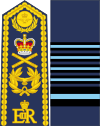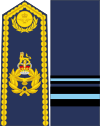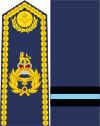RAF officer ranks
This article relies largely or entirely on a single source. (February 2013) |
The officer ranks of the Royal Air Force, as they are today, were introduced in 1919. Prior to that Army ranks were used.
Ranks
| NATO code | OF-10
|
OF-9
|
OF-8
|
OF-7
|
OF-6
|
OF-5
|
OF-4
|
OF-3
|
OF-2
|
OF-1
|
OF(D) | |
|---|---|---|---|---|---|---|---|---|---|---|---|---|
epaulette rank insignia |

|

|

|

|

|

|

|

|

|

|

|

|
| rank title[1] | Marshal of the Royal Air Force | Air Chief Marshal | Air Marshal | Air Vice-Marshal | Air Commodore | Group Captain | Wing Commander | Squadron Leader | Flight Lieutenant | Flying Officer | Pilot Officer | Officer cadet
|
| abbreviation | MRAF[note 1] | Air Chf Mshl | Air Mshl | AVM | Air Cdre | Gp Capt | Wg Cdr | Sqn Ldr | Flt Lt | Fg Off | Plt Off | Off Cdt |
Command flags

|

|

|

|

|

|

|

|
| MRAF | Air Chf Mshl | Air Mshl | AVM | Air Cdre | Gp Capt | Wg Cdr | Sqn Ldr |
Notes
- ^ Marshal of the Royal Air Force has become an honorary/posthumous rank, war time rank; ceremonial rank.
Origins
Lieutenant General
Badges of rank
On 1 April 1918, Air Force Memorandum 2 specified rank insignia for the newly established independent force. Rank was to be worn on the jacket cuff and was derived from the Royal Navy's rings, each equivalent rank having the same number of rings. However, second lieutenants (now pilot officers) displayed a crowned eagle only and the Navy's loop was not used for any rank.[3] Depending on the uniform, either gold or pale blue on grey braid was worn.
In August 1918, Air Ministry Weekly Order 617 added a single band of 1⁄4-inch (6 mm) braid below the second lieutenant's eagle and all other officer ranks also received a crowned eagle above their braid on the left arm only.
In 1919 the colour of the rank braid was changed to black with a central pale blue stripe. However, on RAF
Sleeve ranks
The ranks worn on the sleeve are common to all RAF uniform variants incorporating the Jacket. The centre of the rank (measured from the bottom of the lowest braid to the top of the highest) should be 3+3⁄4 inches (9.5 cm) from the cuff and each row of braiding should have a space of 1⁄8 inch (3 mm) from other rows. The thinnest braid, as found on the pilot officer's rank (and in the middle of the squadron leader's rank), is 1⁄4 inch (6 mm); the flying officer's braid common to all the ranks except air commodore and pilot officer, is 1⁄2 inch (1.3 cm), and the thickest braid, as found on all air officer ranks, is 2 inches (5.1 cm).
Shoulder boards
Shoulder boards (as shown) are worn by officers of general rank equivalent (air commodore and above). Officers entitled to wear
Rank titles
It was initially proposed that each RAF officer rank would be either the equivalent army rank (used by the
On 1 August 1919,
Composite braid

RAF officers typically wear composite braid rank slides with their working and operational uniforms. Composite braid consists of a single piece of fabric, where the "background" between the rank rings is made from blue-grey or olive green material. Composite braid rank slides are often referred to as "bar-code" in RAF slang.[citation needed]
Distinction between ranks and appointments
Many RAF ranks do not imply the appointment or duties of an officer. For example, a pilot officer may well not be trained to pilot an aircraft. In fact, pilots skip the rank of pilot officer and go from officer cadet to flying officer on graduation from officer training school at RAF Cranwell. A squadron leader does not necessarily command a squadron, nor a wing commander necessarily command a wing, nor a group captain command a group.
A group will usually be commanded by an AVM. 'Flying' wings will be commanded by a group captain, with ground-based wings commanded by a wing commander. 'Flying' squadrons are commanded by wing commanders, and ground-based squadrons are typically commanded by squadron leaders.
RAF Air Cadets (Air Training Corps and Combined Cadet Force)
The majority of officers in the
RAF Air Cadets officers use the rank system identical to the regular RAF, but the highest substantive rank is flying officer. Higher ranks within the Air Cadet organisation are acting appointments, up to wing commander. Other senior ranked appointments are generally full-time staff positions (such as regional commandants and commandant air cadets) held by regular and reserve (RAFR/FTRS) RAF officers. In certain circumstances, honorary appointments within the RAF Air Cadets may be made, however the rank may vary. After the
Timeline of changes
See also
- Aircrew brevet
- Comparative military ranks of World War I
- Comparative military ranks of World War II
- Comparative military ranks
- List of Royal Air Force members
- Military rank
- RAF other ranks
- Ranks and insignia of officers in NATO air forces
- Ranks of the cadet forces of the United Kingdom
- Royal Observer Corps ranks
- Women's Auxiliary Air Force ranks
Notes
References
- ^ "RAF Ranks". RAF.MoD.uk. Royal Air Force. n.d. Retrieved 29 August 2023.
- OCLC 462209238.
- ^ "Commissioned Ranks of the Royal Air Force April 1918 - Aug 1919 Initial Uniform Design". Air of Authority. Retrieved 31 March 2017.
- ^ "RAF AP 1358, CHAP 7 - DISTINGUISHING INSIGNIA" (PDF). MOD. 2 August 2010. Archived from the original (PDF) on 7 March 2017. Retrieved 31 March 2017.
- ^ Overy, Richard (1 March 2018). "The Birth of the RAF, 1918: The World's First Air Force". Penguin Books Limited. Retrieved 26 March 2024.
General references
- Hobart, Malcolm. Badges and Uniforms of the Royal Air Force. London/Barnsley, England: Leo Cooper/Pen & Sword Books Ltd., 2000. ISBN 0-85052-739-2.
External links
- RAF Ranks at the official website of the RAF













































